Male Date Palm Flowers & Date Palm Pollen
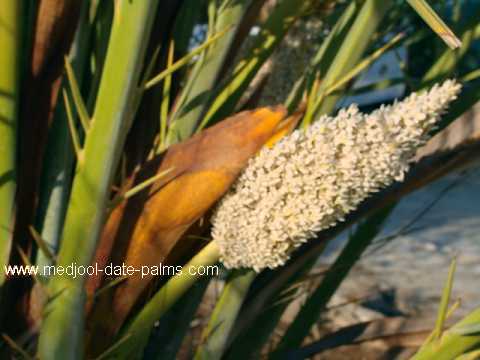
Male Date Palm Flowers:
Source of Date Palm Pollen
Date Palm Flowers & Male Date Palm Pollen
Date palms are dioecious, which means that there are both male date palms and female date palms. After reaching maturity, the male date palm yields flowers that produce the pollen, and the female date palm yields flowers which will become dates, if they are pollinated.
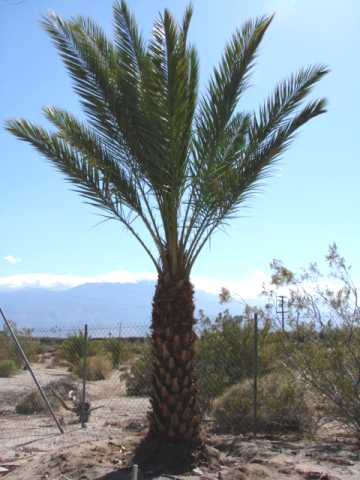 The photo at left shows a mature male date palm standing about 18 feet tall. Mature male date palms usually produce from 5 to 10 large flowers each year.
The photo at left shows a mature male date palm standing about 18 feet tall. Mature male date palms usually produce from 5 to 10 large flowers each year.
The flower stalks of both male and female date palms are produced inside a spathe. The spathe emerges from the axils of the leaves in early spring in mature date palms.
The date palm flowers form within the long stout spathe which, on bursting, exposes many thickly crowded floral branchlets inside. These are thicker and shorter in the male date palm inflorescence, and the branchlets are long and slender in female date palm inflorescence.
Adult female date palms produce from 5 - 20 spathes in early spring. The male flowers are borne single and are waxy white, while the female flowers are borne in clusters of three and are yellowish green in colour.
A male spathe that is ready to split open changes color from green to somewhat brown-ish, and the spathe becomes slightly softer. Immediately after the spathe opens and the male inflorescence appears, these male flowers reach their maturity. Date growers usually harvest the male flowers within 24 hours of when the spathe splits open to avoid loss of pollen.
How to Purchase Date Palm Pollen and Date Palm Flowers
We have fresh male date palm flowers available for sale from late February thru early April each year, for use in pollination and also as a source of fresh date palm pollen.
To purchase fresh date palm male flowers (and date palm pollen), call (909) 941 1060.
Date Palm Polination
Bees are strongly attracted to date palm pollen. Date palms do pollinate naturally by wind, bees and other insects, however the proximity of the male date palms to the females is crucial for such open polination, and date production from open polination is usually very low. Artificial pollination increases
date production substantially. Artificial pollination of date palms is performed using the date palm pollen from male date palm flowers to polinate the female date palm flowers.
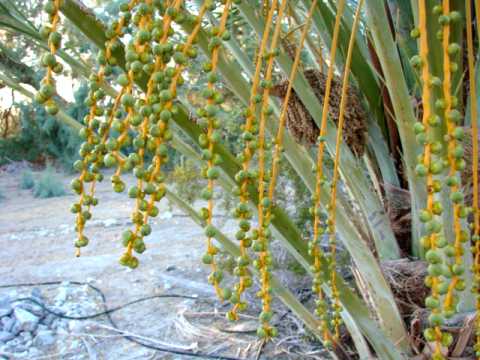
There are several methods of date palm polination in use today. The oldest and simplest pollination technique consists of placing an entire male flower spathe in the crown of the female date palm and leaving the pollination to wind, bees and other insects. This technique does not always yield uniform fruit sets unless if several of the male flower spathes are placed in the crown of the female date palm. This requires the availability of numerous male flower spathes.
Successful commercial date production requires artificial pollination to ensure good pollination. In locations where labor is relatively expensive, the pollination is mechanized. Mechanized pollination reduces the number of male date palms needed for pollination. The male/female ratio in a modern commercial date palm plantation with mechanized pollination is generally about 40 females to one male date palm.
The most common technique of pollination in regions with inexpensive labor is to cut the strands of male flowers from a freshly opened male spathe and place two to three of these strands, lengthwise and in an inverted position, between the strands of the female inflorescence after some pollen has been shaken over the female inflorescence.
Date Palms Used For Landscaping in California
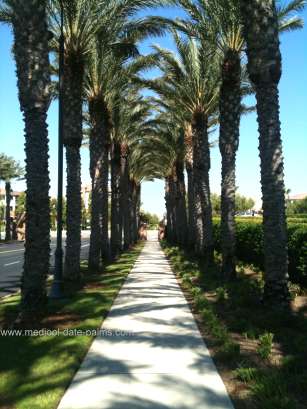 Date palms have recently become very popular as landscape specimens in subtropical areas across the globe, and especially in Southern California! The true date palm varieties of phoenix dactylifera are more expensive than most other types of palms used in landscaping, however these true date palms are very desirable not only for their delicious dates but also for the tropical look they give to any landscape.
Date palms have recently become very popular as landscape specimens in subtropical areas across the globe, and especially in Southern California! The true date palm varieties of phoenix dactylifera are more expensive than most other types of palms used in landscaping, however these true date palms are very desirable not only for their delicious dates but also for the tropical look they give to any landscape.Date palms are very popular because of their striking regal appearance & natural beauty, their ancient history, and also because of their easy maintenance. A date palm can be very impressive as a single specimen, and group plantings can be truly spectacular. The date palm can live to the age of about 200 years, and they can eventually reach heights of about 80 feet tall.
Date palms grow well throughout Southern California where they are used mostly in landscaping.
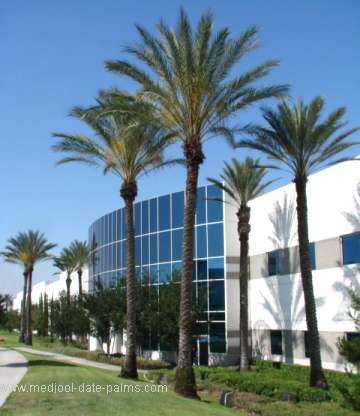
For female date palm landscape use, there are three main date palm varieties used most in landscaping; the Medjool date palm, the Zahidi date palm, and the Deglet Noor date palm. Another less well know date palm variety that is also very desirable for landscaping is the Halawi date palm, which is even larger than the Medjool date palm.
Deglet Noor date palms are commonly planted in shopping centers and malls in southern California where they lend a striking tropical ambience.

Medjool date palms have a larger and more full dense canopy when compared to the Deglet Noor, which has a canopy that is more sparse and open with fewer fronds. The Medjool and Zahidi date palms are somewhat similar in appearance with beautiful silvery green foliage. The Zahidi date palm does have a slightly larger trunk than the Medjool and the Zahidi's canopy is slightly more full and dense - truly a beautiful landscape specimen.
Male date palms do grow taller each year. Once established, their watering schedules can be cut back to slow their growth if desired.
In Southern California it not unusual to see tall date palm specimens providing shade in the parking lots of convenience stores and fast food restuarants. Tall date palms are also very popular in landscape designs for commercial buildings.
In recent years, male date palms have also become very popular in residential landscaping providing a "tropical" look to any yard or garden.
To purchase male date palms in California (and male date palm flowers), call (909) 941 1060.
Date Developement and Ripening Stages
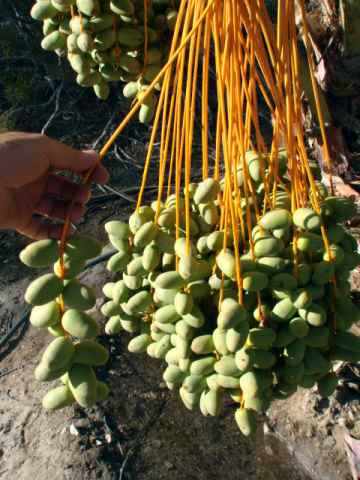
The kimri stage lasts about 5 months and is basically while the dates are green. The next ripening stage is the khalal stage when the dates have grown to their maximum size and turn yellowish or reddish depending on the specific date variety. Next comes the rutab stage, when the dates begin to soften and lose their bright colors. The date becomes fully mature at the tamar stage.
Most date varieties are eaten at the fully mature tamar stage, although some of the very soft varieties like the the Halawy dates (also known as Halawi) and the Barhi dates are also eaten at Khalal stage, when they are sweet and crunchy. We have fresh dates available each year at this khalal stage of ripening.
The Honey Jewel date is also very delicious, soft and amazingly sweet like honey in its fully ripe tamar stage. The Honey Jewel date has been repeatedly voted as the most delicious date variety at our Fresh Picked Tamar Tastings the last 4 years in a row, winning out even over the famously popular medjool date.
Dates are classified as soft, semi-dry, and dry. The dry dates are commonly used in the middle east for everyday consumption. The sweeter dates are used as a dessert in the Middle East as well as in the United States.
Mature female date palms yield from 100 to 250 pounds of dates per palm each year. One of the most important factors in date yield is the amount of irrigation water they receive while the dates are developing.
While the dates are maturing on the palm, the dates are preyed upon by birds, small mammals, and insects. Date farmers sometimes place a protective bag around each date cluster to prevent access to the dates and also for rain protection in some climates. The cultivation of dates requires a significant amount of manual labor and it can be dangerous in tall palms! Some date varieties are much more vulnerable to moisture. Soft dates are much more difficult to cultivate and they do require extensive care & special handling at the final ripening stage.
Medjool Dates & Medjool Date Palms
Among the sweeter date varieties is the Medjool Date, which is considered by many to be the "king of dates". The medjool date was once reserved only for the royal family of the Sultan of Morocco! This amazing date palm variety was first imported into the USA from the Bou Denib Oasis in Morocco in 1927.
The medjool date is most well known for its unusually large size and its delicious flavor. It can grow to about three inches long, and even though it is classified as a soft date the medjool date is firmer and more resilient than most other soft dates and it handles much better as well, making it a great choice for commercial production.
The Medjool date was brought to the United States through the United States Department of Agriculture. There was a disease in Morocco that was spreading quickly among the Medjool date palms and a Moroccan official offered some shoots to a representative from the USDA which in turn were eventually planted in California. The medjool is now thriving in California as one of the primary date cultivars.
Medjool date palms are also very popular for landscaping because of their regal appearance and full canopy. Medjool date palms have a larger and more full dense canopy when compared to the Deglet Noor, which has a canopy that is more sparse and open with fewer fronds. The Medjool and Zahidi date palms are more similar in appearance with beautiful silvery green foliage.
Male Date Palms

Male date palms have recently become a popular choice for residential and commercial landscape designs because the male date palms do not produce the yearly date crop which attracts birds, rodents and insect pests. Male date palms also tend to grow more vigorously and to reach greater heights in fewer years because they do not use their energy producing dates each year like the female date palms.
Male date palms are usually grown from seed. However, when a male date palm seedling has superior pollinating chacteristics like larger flowers or higher quality pollen, then this superior male date palm is propagated by removing its offshoots. In regions where the growing of dates is widespread, selected male date palm cultivars are often given names. The offshoots and flowers of these superior male date palms are sought by date growers for pollinating the female date palms.
We remove selected male date palm offshoots each spring from superior male date palms. These recently removed male date palm offshoots are very perishable until they have formed their own roots. When we romove the male date palm offshoots, we immediately plant them in containers and keep them in shaded nursery conditions. They take up a year or more to develop their own roots & put out vigorous new growth, at which time they are ready to be removed from their containers and planted.
We have these superior male date palm rooted offshoots in stock in 15 & 25 gallon pots and also larger male date palm offshoots in 36 inch wooden boxes - call 909 941 1060 for sales info in California.
How To Buy Medjool Date Palms & other Date Palm Varieties
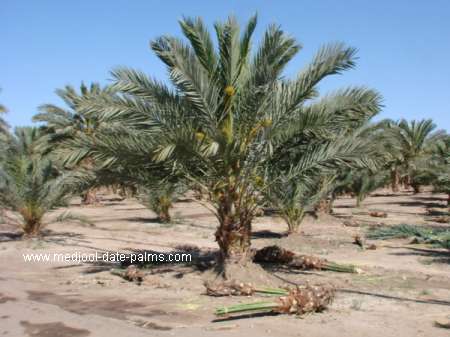
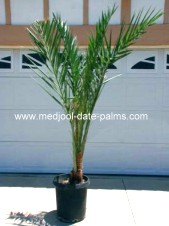
We specialize in already rooted medjool date palm offshoots in containers.
Please call 909 941 1060 for current medjool date palm price & availablilty in California.
In addition to our male date palm offshoots, we offer a variety of female date palm cultivars including medjool date palms offshoots, zahidi date palm offshoots, halawi date palm offshoots, and barhi date palm offshoots.
Our Medjool date palm offshoots are available in all sizes from recently removed pups or "offshoots" to full grown mature palms.
We have female Zahidi date palm offshoots & Medjool date palm offshoots in stock right now, with more Barhi date palm offshoots and Halawi date palm offshoots available again soon.
Male date palms are a popular choice for use in landscaping, and also as a source of date palm pollen for pollination of female date palms. Female date palms produce dates, and they are planted in large plantations for commercial date production. Male date palms for landscaping are less expensive than most female date palm cultivars, and some female date palms grown from off-shoots of specific date cultivars have very limited availability and high demand (the Barhi date palm, for example...).

We have smaller size female medjool date palm rooted offshoots for sale in 15 gallon pots & 25 gallon pots for those who wish to grow their own dates at home in their yard, and we also have some female medjool date palm rooted offshoots for sale in larger wooden boxes & in 65 gallon pots. Larger size mature female medjool date palms are available for transplant directly from the field as well, however transplanted palms usually go thru a period of die-back at the time of transplant while rooted offshoots in containers keep right on growing with no die-back when cared for properly.
Our smaller size male date palm offshoots are also for sale in 15 gallon pots and in 25 gallon pots (male date palms are used for polination & for landscaping).
Our female medjool date palm "rooted" offshoots are in containers. After these medjool palm pups are removed from their medjool mother palms, they have to develope their own roots which takes several months, and they then begin to put out new growth. Our 8 year old female medjool date palm rooted off-shoots stand about 7 to 8 feet tall. These rooted medjool off-shoots are ready for planting.
Please call 909 941 1060 for price information and how to purchase in California.
Older mature date palm trees are sold based on their age and the amount of woody trunk the palm has: a recently removed pup usually has about 1 foot of woody trunk, a 12 foot tall date palm has about 3 feet of woody trunk, and a 20 foot tall date palm has about 10 feet of woody trunk.
Date palm rooted offshoots in containers experience no die-back when properly planted and cared for.
Larger date palms however, that are dug up in the field and shipped directly to the customer usually experience severe die-back lasting a year or more before vigorous growth returns, and a significant percentage frequently may not survive if not properly cared for. For this reason, we always recommend planting rooted date palm offshoots in containers rather than purchasing date palms directly from the field.
Please call 909 941 1060 for current price & availablilty of rooted date palm off-shoots in containers.
Fresh Medjool Dates For Sale
We grow our delicious medjool dates by the "true organic" method with no pesticides, no chemical fertilizers, and no preservatives of any kind; they are pure naturally sweet medjool dates! Did you know that medjool dates are 100% fat free? Our fresh picked medjool dates are available for purchase each year in October, just in time for Christmas!
This year, we will once again have a limited quantity of fresh picked organically grown large medjool dates available. Each year we do sell out before the crop is picked, so be sure to place your order early! We will begin taking orders for this year's medjool date crop on September 15.
Frequently Asked Questions
- SHIPPING: For medjool date palm offshoots in 15 & 25 gallon containers, we recommend that you transport the date palms in your pick-up truck. Local delivery to your driveway can usually be arranged (only in Southern California) with a delivery cost from $50 to $150 depending on the round-trip mileage (50 mile maximum round-trip travel distance). Transport for large medjool date palms can also be arranged in Southern California.
- Our medjool dalm palm rooted offshoots (and our other date palm cultivars) are grown near Indio, California. Smaller size medjool date palms are available for pick-up in Rancho Cucamonga, California, by appointment only. Delivery of medjool date palm trees to customers in Southern California can be arranged. We do recommend that you hire an experienced landscaper (we do not offer landscaping services!) for planting and irrigation of date palms.
- Sub Tropical Fruit Trees: Available for pick-up in Rancho Cucamonga, California, by appoinment only, at one of our two locations.
- PAYMENT: We accept Cash, Check, American Express, Visa, Mastercard & Discover. You can pay in advance or at the time of pick up.
- MEDJOOL DATES: fresh picked medjool dates are available each year in October, organically grown in California.
- GUARANTEE: We guarantee our plants, fruits and trees to be in good condition at the time of sale.
- For all other questions, you may contact us at: Tropical Oasis Farms, PO Box 1011, Rancho Cucamonga, California 91729
© Copyright 2000-2025 - medjool-date-palms.com® - All Rights Reserved.